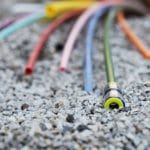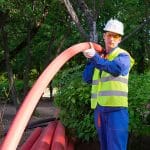
The Benefits of Fiber Optics for School Systems
Back in 2016, the United Nations declared internet access a human right because of its essential nature in obtaining information. Most people still considered the internet a luxury, however, until COVID-19 forced schools worldwide to adopt an online education format. If any school systems did not already recognize the importance of high-capacity internet prior to the global pandemic, they do now.
The need for upgraded networks is greater today than ever before. The best option for increasing speed and bandwidth while offering durability and security is fiber optics, which provides a number of important benefits to schools.
Speed
Fiber optic cables use light for sending and receiving data, making them much faster than the old copper cables that still connect many school systems. High-speed broadband allows for synchronous upload and download speeds, providing users with instantaneous access to online resources. Student devices, including smart phones, tablets, and laptops, run much more quickly and efficiently on fiber optic cables, allowing for higher levels of engagement.
Data Security
Schools maintain large amounts of sensitive information, so data security is a major priority. Copper cables are subject to electromagnetic interference (EMI), which can hinder messages and even create security risks. Unlike traditional cabling systems, fiber optic networks use light transmission that does not generate EMI. This means that school fiber optics are more secure, keeping private educational information safe from cyber criminals.
Options for Teachers
Teachers will benefit from fiber optic cables just as much as students. With outdated networks, teachers hesitated to include online resources, which would frequently lag or spool, causing students to lose interest. Because of the high-speed capabilities of fiber optics, educators can incorporate web-based videos and other materials into their lessons. Computerized testing also speeds up grading processes, freeing teachers to focus on lesson planning and other priorities.
Streamlined Administrative Tasks
Fiber networks for schools enable quick and efficient management of routine administrative tasks. Digital automation can be utilized for taking attendance, ordering educational supplies, entering student assessment information, creating student schedules, and placing lunch orders. By speeding up these processes with cloud-based technology and secure methods of communication, school staff can spend their time on important student education issues.
Safety
School safety has become a top priority in recent years and school systems are investing heavily on security features to protect students and faculty while they are inside a school. Fiber optic cables offer a major benefit in this area, making it possible for security cameras to be installed throughout a school building. The local police or school security department can connect to these cameras to maintain surveillance inside a school at any given time.
Online Education
The speed of fiber optics allows for new ways of learning. Digital technology enables web-based testing, digital classrooms, and online blackboards. Students have access to a broad scope of information, far beyond what can fit in a textbook. High-speed broadband allows learners to take part in virtual tours, interact with experts in remote areas, and utilize simulation software for complex topics.
Durability
The amount of data consumed by students increases every year with greater use of technology, which increases the requirement for more bandwidth. School systems that invest in a modern fiber optic infrastructure are setting up for future operating needs without necessitating cable replacement. A quality fiber optics network can potentially last decades and is predicted to support increasing demands with future technology. On the other hand, the average lifespan of copper cabling is around five years.
There are still some significant challenges facing school systems that want to implement fiber optics, especially those in underserved and rural areas. However, the efforts to increase fiber networks to support 5G is rapidly expanding the service into smaller communities and school systems. There are also federal programs committed to expanding broadband infrastructure. If your school system is not yet using fiber optics, contact V1 Fiber for additional information.





No Comments
Sorry, the comment form is closed at this time.